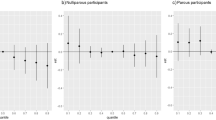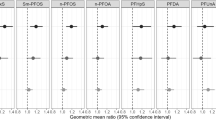Abstract
Background
Exposure to per and poly-fluoroalkyl substances (PFAS) is suggested to interfere with the central nervous system that may affect mental health. Studies on the relationships between exposure to PFAS mixtures and anxiety in humans are rare. This study aimed to evaluate the associations between single and combined exposure to PFAS and anxiety among adults.
Methods
Data were extracted from the National Health and Nutrition Examination Survey (NHANES, 2007–2012). Six serum PFAS concentrations were accessed including perfluorooctanoic acid (PFOA), perfluorononanoic acid (PFNA), PFOS (perfluorooctanesulfonic acid), PFHxS (perfluorohexane sulfonate), PFDA (perfluorodecanoic acid), Me-PFOSA-AcOH (2-(N-methylperfluorooctanesulfonamide) acetic acid). The anxiety state was defined through the questionnaire responses of the participants. Weighted logistics regression was used to calculate their odds ratio (OR) and corresponding confidence interval (95% CI) that assessed the relationship between PFAS exposure and anxiety. Moreover, Two different statistical methods including quantile-based g-computation (Qgcomp), and Bayesian kernel machine regression (BKMR) were employed to investigate the overall effects of PFAS mixtures on anxiety.
Results
The effects of specific PFAS exposure on anxiety varied by sex. In male participants, one-unit increase in PFDA (OR = 0.62; 95%CI: 0.44, 0.88), PFOA (OR = 0.60; 95%CI: 0.41, 0.87), PFNA (OR = 0.68; 95%CI: 0.46, 0.96) concentrations were inversely linked to anxiety. In female participants, a one-unit increase in PFOA (OR = 1.50; 95%CI: 1.05, 2.14) concentration was associated with anxiety. Analysis of Qgcomp demonstrated that PFAS mixtures were negatively associated with anxiety in males (OR = 0.85; 95%CI: 0.74, 0.99), and were positively associated with anxiety in females(OR = 1.16; 95%CI: 1.01, 1.33). Analysis of BKMR suggested that PFAS mixtures were negatively associated with anxiety in the males, while its associations with anxiety were positive in the females.
Impact
-
Although a growing number of studies have focused on the relationship between PFAS and anxiety, most have been performed based on animal observations rather than human populations, and the combined effects of PFAS mixtures on anxiety have not been evaluated. To address these gaps, this study first explored the associations between individual PFAS and PFAS mixture exposures and anxiety among US adults. Using data from the National Health and Nutrition Examination Survey, we demonstrated that co-exposure to a mixture of PFAS was negatively associated with anxiety in males, and its association was contrary in females.
This is a preview of subscription content, access via your institution
Access options
Subscribe to this journal
Receive 6 print issues and online access
269,00 € per year
only 44,83 € per issue
Buy this article
- Purchase on SpringerLink
- Instant access to full article PDF
Prices may be subject to local taxes which are calculated during checkout



Similar content being viewed by others
Data availability
The datasets used for these analyses are publicly available (https://wwwn.cdc.gov/nchs/nhanes/Default.aspx).
References
Charlson F, van Ommeren M, Flaxman A, Cornett J, Whiteford H, Saxena S. New WHO prevalence estimates of mental disorders in conflict settings: a systematic review and meta-analysis. Lancet. 2019;394:240–8.
Kumar A, Bartoli B, Lichand G, Wolf S. Sociodemographic predictors of depression and anxiety symptomatology among parents in rural Côte d’Ivoire. J Affect Disord. 2023;338:1–9.
Gandy M, Sharpe L, Perry KN. Psychosocial predictors of depression and anxiety in patients with epilepsy: a systematic review. J Affect Disord. 2012;140:222–32.
Russell JJ, Moskowitz DS, Zuroff DC, Bleau P, Pinard G, Young SN. Anxiety, emotional security and the interpersonal behavior of individuals with social anxiety disorder. Psychol Med. 2011;41:545–54.
Kris-Etherton PM, Petersen KS, Hibbeln JR, Hurley D, Kolick V, Peoples S, et al. Nutrition and behavioral health disorders: depression and anxiety. Nutr Rev. 2021;79:247–60.
Tillaut H, Monfort C, Rouget F, Pelé F, Lainé F, Gaudreau E, et al. Prenatal exposure to perfluoroalkyl substances and child behavior at age 12: A PELAGIE Mother-Child Cohort Study. Environ Health Perspect. 2023;131:117009.
Guo M, Yu Y, Liu H, Zhu C. Associations between exposure to a mixture of perfluoroalkyl and polyfluoroalkyl substances and age at menarche in adolescent girls utilizing three statistical models. Chemosphere. 2023;335:139054.
Liang D, Taibl KR, Dunlop AL, Barr DB, Ryan PB, Everson T, et al. Metabolic perturbations associated with an exposure mixture of per- and polyfluoroalkyl substances in the Atlanta African American Maternal-Child Cohort. Environ Sci Technol. 2023;57:16206–18.
Cao Y, Ng C. Absorption, distribution, and toxicity of per- and polyfluoroalkyl substances (PFAS) in the brain: a review. Environ Sci Process Impacts. 2021;23:1623–40.
Foguth RM, Hoskins TD, Clark GC, Nelson M, Flynn RW, de Perre C, et al. Single and mixture per- and polyfluoroalkyl substances accumulate in developing Northern leopard frog brains and produce complex neurotransmission alterations. Neurotoxicol Teratol. 2020;81:106907.
Rericha Y, Truong L, Leong C, Cao D, Field JA, Tanguay RL. Dietary perfluorohexanoic acid (PFHxA) exposures in juvenile zebrafish produce subtle behavioral effects across generations. Toxics. 2022;10:372.
Merrill AK, Conrad K, Marvin E, Sobolewski M. Effects of gestational low dose perfluorooctanoic acid on maternal and “anxiety-like” behavior in dams. Front Toxicol. 2022;4:971970.
Aung MT, Eick SM, Padula AM, Smith S, Park JS, DeMicco E, et al. Maternal per- and poly-fluoroalkyl substances exposures associated with higher depressive symptom scores among immigrant women in the Chemicals in Our Bodies cohort in San Francisco. Environ Int. 2023;172:107758.
Kuklenyik Z, Needham LL, Calafat AM. Measurement of 18 perfluorinated organic acids and amides in human serum using on-line solid-phase extraction. Anal Chem. 2005;77:6085–91.
Gui J, Ding R, Huang D, Wang L, Han Z, Yang X, et al. Associations between urinary heavy metals and anxiety among adults in the National Health and Nutrition Examination Survey (NHANES), 2007-2012. Chemosphere. 2023;341:140085.
Dzierlenga MW, Keast DR, Longnecker MP. The concentration of several perfluoroalkyl acids in serum appears to be reduced by dietary fiber. Environ Int. 2021;146:106292.
Sun X, Yang X, Zhang Y, Liu Y, Xiao F, Guo H, et al. Correlation analysis between per-fluoroalkyl and poly-fluoroalkyl substances exposure and depressive symptoms in adults: NHANES 2005-2018. Sci Total Environ. 2024;906:167639.
Yang X, Xue Q, Wen Y, Huang Y, Wang Y, Mahai G, et al. Environmental polycyclic aromatic hydrocarbon exposure in relation to metabolic syndrome in US adults. Sci Total Environ. 2022;840:156673.
Klein BE, Klein R, Lee KE. Components of the metabolic syndrome and risk of cardiovascular disease and diabetes in Beaver Dam. Diabetes Care. 2002;25:1790–4.
Bobb JF, Claus Henn B, Valeri L, Coull BA. Statistical software for analyzing the health effects of multiple concurrent exposures via Bayesian kernel machine regression. Environ Health. 2018;17:67.
Bobb JF, Valeri L, Claus Henn B, Christiani DC, Wright RO, Mazumdar M, et al. Bayesian kernel machine regression for estimating the health effects of multi-pollutant mixtures. Biostatistics. 2015;16:493–508.
Liu WZ, Zhang WH, Zheng ZH, Zou JX, Liu XX, Huang SH, et al. Identification of a prefrontal cortex-to-amygdala pathway for chronic stress-induced anxiety. Nat Commun. 2020;11:2221.
Adhikari A, Topiwala MA, Gordon JA. Synchronized activity between the ventral hippocampus and the medial prefrontal cortex during anxiety. Neuron. 2010;65:257–69.
McCall JG, Al-Hasani R, Siuda ER, Hong DY, Norris AJ, Ford CP, et al. CRH engagement of the locus coeruleus noradrenergic system mediates stress-induced anxiety. Neuron. 2015;87:605–20.
Adedara IA, Souza TP, Canzian J, Olabiyi AA, Borba JV, Biasuz E, et al. Induction of aggression and anxiety-like responses by perfluorooctanoic acid is accompanied by modulation of cholinergic- and purinergic signaling-related parameters in adult zebrafish. Ecotoxicol Environ Saf. 2022;239:113635.
Foguth RM, Flynn RW, de Perre C, Iacchetta M, Lee LS, Sepúlveda MS, et al. Developmental exposure to perfluorooctane sulfonate (PFOS) and perfluorooctanoic acid (PFOA) selectively decreases brain dopamine levels in northern leopard frogs. Toxicol Appl Pharmacol. 2019;377:114623.
Du Y, Li Q, Zhou G, Cai Z, Man Q, Wang WC. Early-life perfluorooctanoic acid exposure disrupts the function of dopamine transporter protein with glycosylation changes implicating the links between decreased dopamine levels and disruptive behaviors in larval zebrafish. Sci Total Environ. 2024;917:170408.
Wang Y, Zhang Y, Shi Z, Di T, Yu W, Chen L. Exposure of male mice to perfluorooctanoic acid induces anxiety-like behaviors by increasing corticotropin-releasing factor in the basolateral amygdala complex. Chemosphere. 2022;287:132170.
Liu S, Qiu W, Li R, Chen B, Wu X, Magnuson JT, et al. Perfluorononanoic acid induces neurotoxicity via synaptogenesis signaling in zebrafish. Environ Sci Technol. 2023;57:3783–93.
Lazarevic N, Smurthwaite KS, Batterham PJ, Lane J, Trevenar SM, D’Este C, et al. Psychological distress in three Australian communities living with environmental per- and polyfluoroalkyl substances contamination. Sci Total Environ. 2023;874:162503.
Moulinet I, Landeau B, Touron E, De La Sayette V, Desgranges B, Vivien D, et al. Sex-specificities in anxiety and depressive symptoms across the lifespan and their links with multimodal neuroimaging. J Affect Disord. 2022;296:593–602.
Toufexis D. Region- and sex-specific modulation of anxiety behaviours in the rat. J Neuroendocrinol. 2007;19:461–73.
Dennerstein L, Randolph J, Taffe J, Dudley E, Burger H. Hormones, mood, sexuality, and the menopausal transition. Fertil Steril. 2002;77 Suppl 4:S42–8.
Thanky NR, Son JH, Herbison AE. Sex differences in the regulation of tyrosine hydroxylase gene transcription by estrogen in the locus coeruleus of TH9-LacZ transgenic mice. Brain Res Mol Brain Res. 2002;104:220–6.
Xie X, Weng X, Liu S, Chen J, Guo X, Gao X, et al. Perfluoroalkyl and polyfluoroalkyl substance exposure and association with sex hormone concentrations: results from the NHANES 2015-2016. Environ Sci Eur. 2021;33:69.
Seo D, Ahluwalia A, Potenza MN, Sinha R. Gender differences in neural correlates of stress-induced anxiety. J Neurosci Res. 2017;95:115–25.
Tang C, Wang Y, Hong H. Unraveling the link between heavy metals, perfluoroalkyl substances and depression: Insights from epidemiological and bioinformatics strategies. Ecotoxicol Environ Saf. 2024;279:116482.
Schildroth S, Claus Henn B, Vines AI, Geller RJ, Lovett SM, Coleman CM, et al. Per- and polyfluoroalkyl substances (PFAS), perceived stress, and depressive symptoms in a prospective cohort study of black women. Sci Total Environ. 2024;929:172445.
Howren MB, Lamkin DM, Suls J. Associations of depression with C-reactive protein, IL-1, and IL-6: a meta-analysis. Psychosom Med. 2009;71:171–86.
Avenevoli S, Swendsen J, He JP, Burstein M, Merikangas KR. Major depression in the national comorbidity survey-adolescent supplement: prevalence, correlates, and treatment. J Am Acad Child Adolesc Psychiatry. 2015;54:37–44.e2.
Slavich GM, Sacher J. Stress, sex hormones, inflammation, and major depressive disorder: extending social signal transduction theory of depression to account for sex differences in mood disorders. Psychopharmacology. 2019;236:3063–79.
Acknowledgements
The authors thank the National Health and Nutrition Examination Survey for publicly available data.
Funding
This manuscript was supported by the Scientific Research Promotion Plan of Anhui Medical University (2021xkjT013), Project of Anhui Provincial Academic and Technical Leaders for Scientific Research Activities (2022D321), Projects of Anhui Provincial Key Laboratory of Population Health and Aristogenics (JKYS20225), and National Natural Science Foundation of China (No.72374005).
Author information
Authors and Affiliations
Contributions
Xiaoguo Hua performed the data analyses and wrote the manuscript. Rui Hu revised the final typescript. Cai Chen searched and evaluated the retrieved articles. Xiqiu Feng and Jiangjie Sun contributed to the conception of the study. Xiujun Zhang was responsible for the communication of the paper.
Corresponding author
Ethics declarations
Competing interests
The authors declare no competing interests.
Ethics approval
The application of every technique followed all applicable rules and regulations. The US National Center for Healthcare Statistics (NCHS) granted permission for the 2007–2012 NHANES to be conducted.
Informed consent
Informed consent was obtained from all participants.
Additional information
Publisher’s note Springer Nature remains neutral with regard to jurisdictional claims in published maps and institutional affiliations.
Supplementary information
Rights and permissions
Springer Nature or its licensor (e.g. a society or other partner) holds exclusive rights to this article under a publishing agreement with the author(s) or other rightsholder(s); author self-archiving of the accepted manuscript version of this article is solely governed by the terms of such publishing agreement and applicable law.
About this article
Cite this article
Hua, X., Hu, R., Chen, C. et al. Sex specificity in associations between exposure to a mixture of per and poly-fluoroalkyl substances and anxiety among US adults. J Expo Sci Environ Epidemiol (2025). https://doi.org/10.1038/s41370-024-00741-3
Received:
Revised:
Accepted:
Published:
DOI: https://doi.org/10.1038/s41370-024-00741-3



